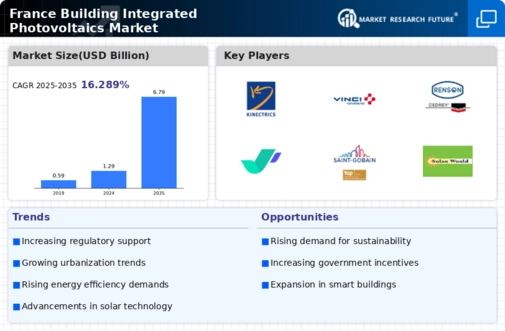Urbanization Trends
Rapid urbanization in France is significantly influencing the building integrated-photovoltaics market. As urban areas expand, the demand for energy-efficient buildings rises, prompting developers to seek innovative solutions. The French urban population is projected to reach approximately 85% by 2030, leading to increased pressure on energy resources. Consequently, integrating photovoltaic systems into building designs offers a viable solution to meet energy demands sustainably. This trend is particularly evident in metropolitan areas like Paris, where space is limited, and energy efficiency is paramount. The building integrated-photovoltaics market is likely to thrive as urban planners and architects prioritize sustainable energy solutions in their projects.
Sustainability Initiatives
The increasing emphasis on sustainability within the construction sector is a pivotal driver for the building integrated-photovoltaics market. In France, the government has set ambitious targets to reduce greenhouse gas emissions by 40% by 2030. This commitment encourages the integration of renewable energy solutions, such as photovoltaics, into building designs. As a result, architects and developers are increasingly incorporating solar technologies into new constructions and renovations. The building integrated-photovoltaics market is expected to benefit from this trend, as it aligns with the broader goals of sustainable urban development. Furthermore, the French population's growing environmental consciousness is likely to drive demand for energy-efficient buildings, further propelling the market forward.
Government Policy and Regulation
Government policy and regulation are critical drivers for the building integrated-photovoltaics market in France. The French government has established a regulatory framework that encourages the adoption of renewable energy solutions in the construction sector. For example, the Energy Transition Law mandates that new buildings must meet specific energy performance standards, which often include the integration of renewable energy sources. This regulatory environment creates a favorable landscape for the building integrated-photovoltaics market, as compliance with these standards necessitates the incorporation of solar technologies. As regulations continue to evolve, the market is likely to see increased demand for innovative photovoltaic solutions that meet these stringent requirements.
Economic Incentives for Renewable Energy
Economic factors play a crucial role in shaping the building integrated-photovoltaics market in France. The government has introduced various financial incentives to promote renewable energy adoption, including tax credits and subsidies for solar installations. For instance, the French government has allocated €1.5 billion to support renewable energy projects, which includes funding for building integrated-photovoltaics. These economic incentives not only lower the initial investment costs for developers but also enhance the return on investment for building owners. As a result, the building integrated-photovoltaics market is likely to experience growth as more stakeholders recognize the financial benefits of integrating solar technologies into their properties.
Technological Integration in Construction
The advancement of construction technologies is a significant driver for the building integrated-photovoltaics market. Innovations such as Building Information Modeling (BIM) and smart building technologies facilitate the seamless integration of photovoltaic systems into architectural designs. In France, the adoption of these technologies is on the rise, with an estimated 30% of construction projects utilizing BIM by 2025. This trend allows for more efficient planning and execution of solar installations, ultimately enhancing the performance of building integrated-photovoltaics. As construction firms increasingly embrace these technologies, the market is expected to benefit from improved efficiency and reduced costs associated with solar energy integration.





















Leave a Comment